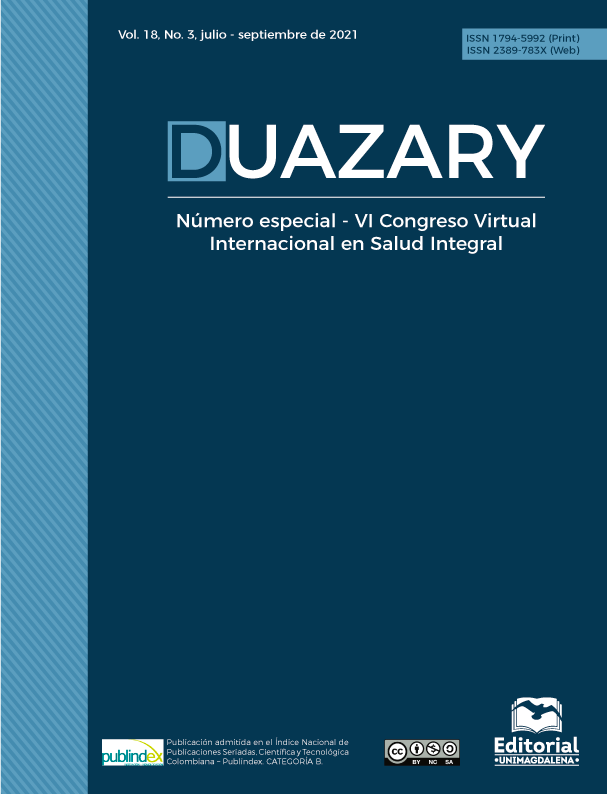Coronas implantosoportadas: una alternativa de tratamiento restaurador en paciente con bruxismo. Reporte de caso
Contenido principal del artículo
Resumen
El bruxismo es un hábito parafuncional que ocurre durante el sueño y/o la vigilia. Siendo más común el bruxismo del sueño, se presenta en el 17% de la población mundial. Por lo general, cuando es persistente provoca detrimento en la salud oral. No se ha establecido un tratamiento efectivo contra esta parafunción. El bruxismo también se ha considerado como factor de riesgo para la instalación de implantes y se ha asociado con un aumento de complicaciones mecánicas en la rehabilitación protésica. Aunque algunos autores consideran que el bruxismo no afecta la supervivencia del implante, es de suma importancia considerar todos los aspectos relacionados que contribuyan a reducir los efectos de este hábito en rehabilitación implantosoportada. En este estudio, se presenta el caso de un paciente masculino de 58 años, bruxista, rehabilitado sobre implantes dentales con éxito, después de dos años de instalación. Además, se exponen recomendaciones que ayuden a minimizar los efectos nocivos, cuando se diagnostique un paciente bruxista y se pretenda rehabilitar sobre implantes dentales
Descargas
Detalles del artículo

Esta obra está bajo una licencia internacional Creative Commons Atribución-NoComercial-CompartirIgual 4.0.
No se permite un uso comercial de la obra original ni de las posibles obras derivadas, la distribución de las cuales se debe hacer con una licencia igual a la que regula la obra original.
Citas
Lavigne GJ, Rompre PH, Montplaisir JY. Sleep Bruxism: Validity of Clinical Research Diagnostic Criteria in a Controlled Polysomnographic Study. J Dent Res. 1996 Jan 8;75(1):546–52. Doi: https://doi.org/10.1177/00220345960750010601
Lobbezoo F, Ahlberg J, Glaros AG, Kato T, Koyano K, Lavigne GJ, et al. Bruxism defined and graded: An international consensus. J Oral Rehabil. 2013;40(1):2–4. Doi: https://doi.org/10.1111/joor.12011
Wetselaar P, Vermaire EJH, Lobbezoo F, Schuller AA. The prevalence of awake bruxism and sleep bruxism in the Dutch adult population. J Oral Rehabil. 2019;46(7):617–23. Doi: https://doi.org/10.1111/joor.12787
Johansson A, Omar R, Carlsson GE. Bruxism and prosthetic treatment: A critical review. J Prosthodont Res. 2011;55(3):127–36. Doi: https://doi.org/10.1016/j.jpor.2011.02.004
Manfredini D, Poggio CE, Lobbezoo F. Is Bruxism a Risk Factor for Dental Implants? A Systematic Review of the Literature. Clin Implant Dent Relat Res. 2014;16(3):460–9. Doi: https://doi.org/10.1111/cid.12015
Lobbezoo F, Ahlberg J, Manfredini D, Winocur E. Are bruxism and the bite causally related? J Oral Rehabil. 2012;39(7):489–501. Doi: https://doi.org/10.1111/j.1365-2842.2012.02298.x
Macedo CR, Silva AB, Machado MA, Saconato H, Prado GF. Occlusal splints for treating sleep bruxism (tooth grinding). Cochrane Database Syst Rev. 2007;(4):CD005514. Doi: https://doi.org/10.1002/14651858.CD005514.pub2
Lobbezoo F, Van Der Zaag J, Naeije M. Bruxism: Its multiple causes and its effects on dental implants - An updated review. J Oral Rehabil. 2006;33(4):293–300. Doi: https://doi.org/10.1111/j.1365-2842.2006.01609.x
Chrcanovic BR, Albrektsson T, Wennerberg A. Bruxism and dental implants: A meta-analysis. Implant Dent. 2015;24(5):505–16. Doi: https://doi.org/10.1097/ID.0000000000000298
Zhou Y, Gao J, Luo L, Wang Y. Does Bruxism Contribute to Dental Implant Failure? A Systematic Review and Meta-Analysis. Clin Implant Dent Relat Res. 2016;18(2):410–20. Doi: https://doi.org/10.1111/cid.12300
Zortuk M, Kilic E, Yildiz P, Leblebicioglu I. Effect of parafunctional force on dental implant treatment in bruxism: A case report (two year results). J Int Dent Med Res. 2011;4(1):25–9. Disponible en: ktodermaldisplazi.com/journal/Journal2011/Vol4_No1/6_D1086_Mustafa_Zortuk.pdf
Albrektsson T, Zarb G, Worthington P EA. The long-term efficacy of currently used dental implants: a review and proposed criteria of success. Int J Oral Maxillofac Implant. 1986;1(1):11–25. Disponible en: http://www.quintpub.com/journals/omi/abstract.php?article_id=11202#.YMlfcqhKjIV
Misch CE, Morton P, Wang HL et al. Implant success, survival and failure: The International Congress of Oral Implantologist (ICOI) Pisa Consensus Conference. Implant Dent. 2008;17(1):5–15. Doi: https://doi.org/10.1097/ID.0b013e3181676059
Naert I, Koutsikakis G, Duyck J, Quirynen M, Jacobs R van SD. Biologic outcome of implant-supported restorations in the treatment of partial edentulism. Part 2: a longitudinal radiographic study. Clin Oral Implant Res. 2002;13(4):390–395. Doi: https://doi.org/10.1034/j.1600-0501.2002.130407.x
Lekholm U, Gunne J, Henry P, Higuchi K, Lindén U, Bergström C van SD. Survival of the Brånemark implant in partially edentulous jaws: a 10-year prospective multicenter study. Int J Oral Maxillofac Implant. 1999;14(5):639–45. Disponible en: http://medlib.yu.ac.kr/eur_j_oph/ijom/IJOMI/ijomi_14_639.pdf
Rameh S, Menhall A YR. Key factors influencing short implant success. Oral Maxillofac Surg. 2020;24(3):263–75. Doi: https://doi.org/10.1007/s10006-020-00841-y
Kullar AS, Miller CS. Are There Contraindications for Placing Dental Implants? Dent Clin North Am. 2019;63(3):345–62. Doi: https://doi.org/10.1016/j.cden.2019.02.004
Chen H, Liu N, Xu X, Qu X LES. Smoking, radiotherapy, diabetes and osteoporosis as risk factors for dental implant failure: a meta-analysis. PLoS One. 2013;8(8):e71955. Doi: https://doi.org/10.1371/journal.pone.0071955
Klokkevold PR, Han TJ. How do smoking, diabetes, and periodontitis affect outcomes of implant treatment? Int J Oral Maxillofac Implant. 2007;22:173–202. Doi: https://doi.org/10.1038/bdj.2007.841
Manfredini D, Bucci MB, Sabattini VB LF. Bruxism: overview of current knowledge and suggestions for dental implants planning. Cranio. 2011;24(4):3014–312. Doi: https://doi.org/10.1179/crn.2011.045
Chrcanovic BR, Kisch J, Albrektsson T WA. Bruxism and dental implant treatment complications: a retrospective comparative study of 98 bruxer patients and a matched group. Clin Oral Implant Res. 2017;28(7):e1–9. Doi: https://doi.org/10.1111/clr.12844
De Angelis F, Papi P, Mencio F, Rosella D, Di Carlo S PG. Implant survival and success rates in patients with risk factors: results from a long-term retrospective study with a 10 to 18. Eur Rev Med Pharmacol Sci. 2017;21(3):433–7. Disponible en: https://www.europeanreview.org/wp/wp-content/uploads/433-437-Long-term-follow-up-analysis-of-implant-patients-with-risk-factors.pdf
CE M. Dental implant prosthetics [Internet]. 2 edition. Elsevier Mosby. 2015. 1008 p. Available from: https://www.elsevier.com/books/dental-implant-prosthetics/misch/978-0-323-07845-0
Fernández-Núñez T, Amghar-Maach S G-EC. Efficacy of botulinum toxin in the treatment of bruxism: Systematic review. Med Oral Patol Oral Cir Bucal. 2019;24(4):e416–24. Doi: https://doi.org/10.4317/medoral.22923

